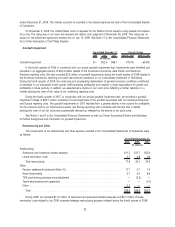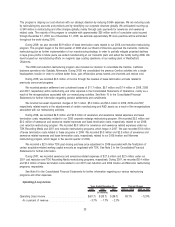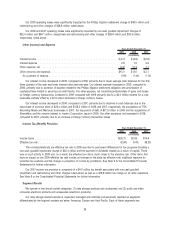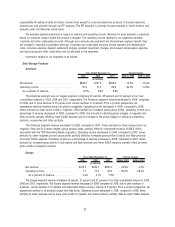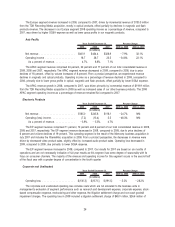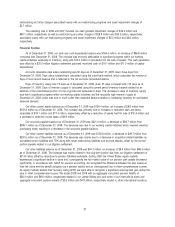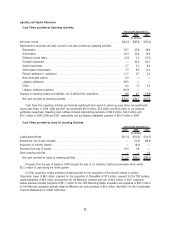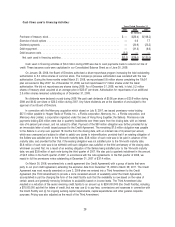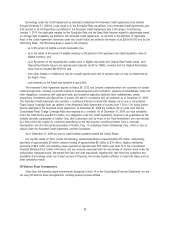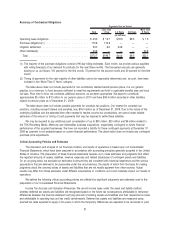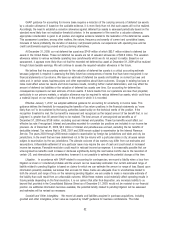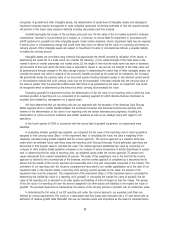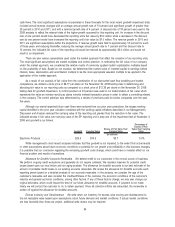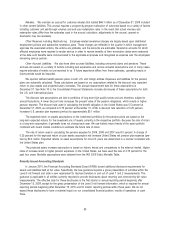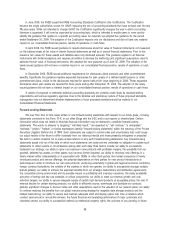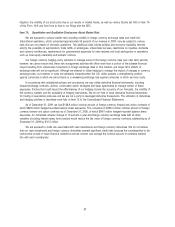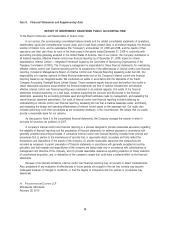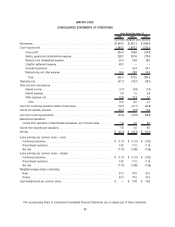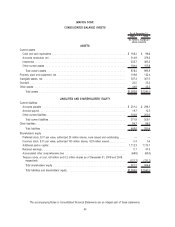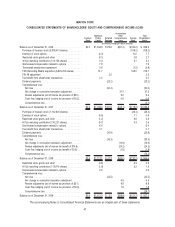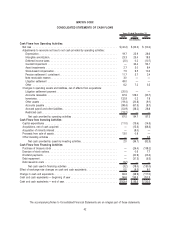Memorex 2009 Annual Report Download - page 39
Download and view the complete annual report
Please find page 39 of the 2009 Memorex annual report below. You can navigate through the pages in the report by either clicking on the pages listed below, or by using the keyword search tool below to find specific information within the annual report.GAAP guidance for accounting for income taxes requires a reduction of the carrying amounts of deferred tax assets
by a valuation allowance if, based on the available evidence, it is more likely than not that such assets will not be realized.
Accordingly, the need to establish a valuation allowance against deferred tax assets is assessed periodically based on the
standard more likely than not realization threshold criterion. In the assessment of the need for a valuation allowance,
appropriate consideration is given to all positive and negative evidence related to the realization of the deferred tax assets.
This assessment considers, among other matters, the nature, frequency and severity of current and cumulative losses,
forecasts of future profitability, the duration of statutory carryforward periods, our experience with operating loss and tax
credit carryforwards expiring unused and tax planning alternatives.
At December 31, 2009, our net deferred tax asset was $74.9 million of which $63.7 million relates to deferred tax
assets in the United States. These net deferred tax assets are net of valuation allowances of $22.9 million. The valuation
allowance relates to various worldwide operating loss carryforwards which we do not expect to realize. Based on our
assessment, it appears more likely than not that the recorded net deferred tax asset at December 31, 2009 will be realized
through future taxable earnings. We will continue to assess the required valuation allowance in the future.
We believe that the accounting estimate for the valuation of deferred tax assets is a critical accounting estimate
because judgment is required in assessing the likely future tax consequences of events that have been recognized in our
financial statements or tax returns. We base our estimate of deferred tax assets and liabilities on current tax laws and
rates and, in certain cases, business plans and other expectations about future outcomes. Changes in existing tax laws or
rates could affect actual tax results and future business results, including further market deterioration, and may affect the
amount of deferred tax liabilities or the valuation of deferred tax assets over time. Our accounting for deferred tax
consequences represents our best estimate of future events. If future results from our operations are less than projected,
particularly in our primary markets, a valuation allowance may be required to reduce deferred tax assets, which could have
a material impact on our results of operations in the period in which it is recorded.
Effective January 1, 2007, we adopted additional guidance for accounting for uncertainty in income taxes. This
guidance defines the threshold for recognizing the benefits of tax return positions in the financial statements as “more
likely than not” to be sustained by the taxing authorities based solely on the technical merits of the position. If the
recognition threshold is met, the tax benefit is measured and recognized as the largest amount of tax benefit that, in our
judgment, is greater than 50 percent likely to be realized. The total amount of unrecognized tax benefits as of
December 31, 2009 was $13.8 million, excluding accrued interest and penalties. These tax benefits would affect our
effective tax rate if recognized. Interest and penalties recorded for uncertain tax positions are included in our income tax
provision. As of December 31, 2009, $2.2 million of interest and penalties was accrued, excluding the tax benefits of
deductible interest. Tax returns filed in 2006, 2007 and 2008 remain subject to examination by the Internal Revenue
Service. The years 2003 through 2008 remain subject to examination by foreign tax jurisdictions and state and city tax
jurisdictions. In the event that we have determined not to file tax returns with a particular state or city, all years remain
subject to examination by the tax jurisdictions. The ultimate outcome of tax matters may differ from our estimates and
assumptions. Unfavorable settlement of any particular issue may require the use of cash and could result in increased
income tax expense. Favorable resolution could result in reduced income tax expense. It is reasonably possible that our
unrecognized tax benefits could increase or decrease significantly during the next twelve months due to the resolution of
certain U.S. and international tax uncertainties; however it is not possible to estimate the potential change at this time.
Litigation. In accordance with GAAP related to accounting for contingencies, we record a liability when a loss from
litigation is known or considered probable and the amount can be reasonably estimated. Our current estimated range of
liability related to pending litigation is based on claims for which we can estimate the amount or range of loss. Based upon
information presently available, we believe that accruals for these claims are adequate. Due to uncertainties related to
both the amount and range of loss on the remaining pending litigation, we are unable to make a reasonable estimate of
the liability that could result from an unfavorable outcome. While these matters could materially affect operating results in
future periods depending on the final resolution, it is our opinion that after final disposition, any monetary liability to us
beyond that provided in the Consolidated Balance Sheet as of December 31, 2009, would not be material to our financial
position. As additional information becomes available, the potential liability related to pending litigation will be assessed
and estimates will be revised as necessary.
Goodwill and Other Intangibles. We record all assets and liabilities acquired in purchase acquisitions, including
goodwill and other intangibles, at fair value as required by GAAP guidance for business combinations. The initial
32


